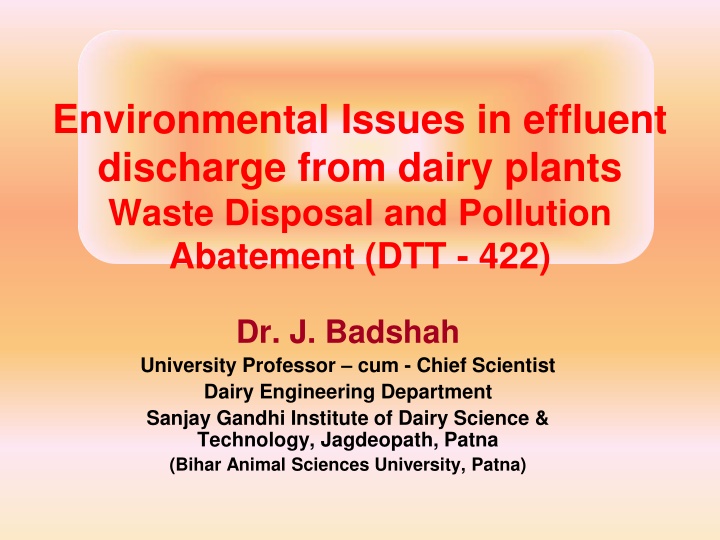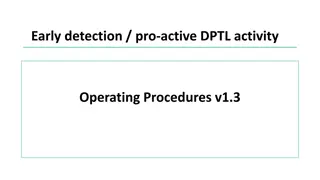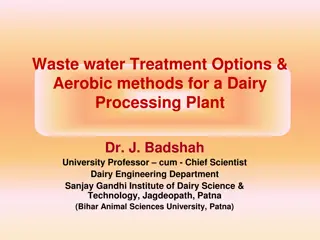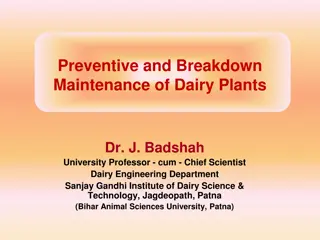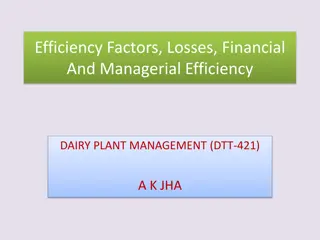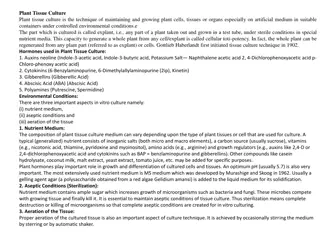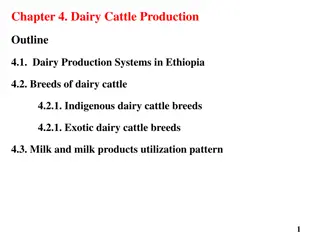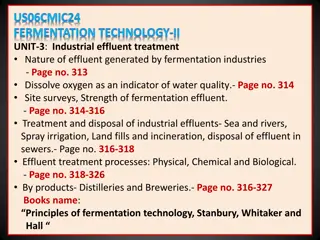Environmental Issues in Dairy Plant Effluent Discharge
Organic components in dairy wastewater, such as proteins, lactose, and fat, impact the environment due to their biodegradability and solubility. This waste contributes to high BOD and COD levels, affecting waterways, atmosphere, land, and solid waste. Management strategies and treatment methods are essential for mitigating pollution.
Download Presentation

Please find below an Image/Link to download the presentation.
The content on the website is provided AS IS for your information and personal use only. It may not be sold, licensed, or shared on other websites without obtaining consent from the author.If you encounter any issues during the download, it is possible that the publisher has removed the file from their server.
You are allowed to download the files provided on this website for personal or commercial use, subject to the condition that they are used lawfully. All files are the property of their respective owners.
The content on the website is provided AS IS for your information and personal use only. It may not be sold, licensed, or shared on other websites without obtaining consent from the author.
E N D
Presentation Transcript
Environmental Issues in effluent discharge from dairy plants Waste Disposal and Pollution Abatement (DTT - 422) Dr. J. Badshah University Professor cum - Chief Scientist Dairy Engineering Department Sanjay Gandhi Institute of Dairy Science & Technology, Jagdeopath, Patna (Bihar Animal Sciences University, Patna)
Environmental Issues in Effluent Discharge The organic components of the wastewater from dairy processing operations classified as proteins, lactose and fat affecting the environment in different ways depending on their biodegradability and their solubility. Dairy effluent contains soluble organics, suspended solids, trace organics. All these components contribute largely towards their high biological oxygen demand (BODS) and chemical oxygen demand (COD). Dairy wastes are white in colour and usually slightly alkaline in nature and become acidic quite rapidly due to the fermentation of milk sugar to lactic acid. The suspended matter content of milk waste is considerable mainly due to fine curd found in cheese waste. The pollution effect of dairy waste is attributed to the immediate and high oxygen demand. Environmental Issues: 1. Effects on waterways 3. Effects on Atmosphere 4. Effects on solid waste 2. Effects on land
Effects on water ways A worldwide issue of scientific and public concern: The occurrence of micropollutants including ingredients of, e.g., pharmaceuticals, pesticides or personal care products in aquatic environments and their potential impact on biota worldwide issue of scientific and public concern. Soure of micropollutants: treatment plants (WWTPs) as major point sources for the release of micropollutants into the water cycle. As removal of micropollutants was not in the particular focus in the past in comparison to other nutrients consequence, the removal of micropollutants insufficient or even completely lacking. a Effluents from wastewater and particular. As a One possibility to improve Additional micropollutants reduction in WWTPs by upgrading with additional treatment steps like ozonation or activated carbon. Treatment:
Effects on Rivers Organic pollution of rivers by wastewater discharge from human activities (cities, farming, industry) ecosystems worldwide through the global sanitation crisis. Untreated urban sewage containing pathogens that cause a variety of diseases, including diarrhoea, globally the leading cause of illness and death. Second, accumulation of organic pollutants in rivers stimulating microbial growth, leading to oxygen depletion and disturbance of the entire river ecosystem. The level of organic pollution in a river, commonly expressed by the Biochemical Oxygen Demand (BOD) due to two counteracting mechanisms: pollutant loading and natural cleaning. Wastewater discharge from cities and intensive livestock farms constituting the main organic pollutant loads into rivers. affecting humans and
Effects on water in Rivers The concentration of oxygen in a river and fish and other aquatic organisms in rivers The rate at which oxygen is consumed by microorganisms and the rate of reaeration from the atmosphere. The usual lower limit for oxygen concentrations in rivers as per servival of sensitive fish species i.e. usually about 6 g/m3 . Fully aerated rivers at temperatures of 15 to 25 C contain oxygen concentrations of at least 8 g/m3 . The discharges to rivers maintain an oxygen concentration of at least 6 g/m3 and the discharge to the river must not increase the river BOD5by more than about 3 g /m3 reaeration characteristics of the river). Sewage Fungus: Low molecular weight organic compounds mainly lactose promote the growth of certain filamentous slimes in waterways resulting in bacterial colonies (mainly Sphaerotilus natans) collectively known as sewage fungus. (depending on the
Effects on water in Rivers Measures of the amount of oxygen that are consumed by bacteria are the Biochemical oxygen demand (BOD5) and the chemical oxygen demand (COD). BOD5is measured as the amount of oxygen that is consumed by bacteria in decomposing the waste over a 5 day period at 20 C. The COD is measured by digesting the waste with boiling sulphuric acid and potassium dichromate in the presence of a catalyst, and the result is expressed as oxygen equivalents. In both cases the organic material is converted to carbon dioxide and water, but with the BOD5test, some of the organic matter is converted to new bacterial cells. The organic components in dairy processing wastewater are highly biodegradable. In waterways, bacteria will consume the organic components of the waste. The process of biodegradation in waterways consumes oxygen according to the following equation: Organic Material + O2 CO2 + H2O + Bacteria
Waste water Discharge effects on land Wastewater application to soils - a common method of waste treatment in the dairy industry The major mechanisms for nutrient (nitrogen and phosphorus) removal in soil based treatment systems i.e. plant uptake and incorporation in animal immobilization in the soil - losses to the atmosphere - losses to groundwater (leaching). products - adsorption and Plant uptake of nitrogen amounting to up to 500 kg / ha/ year. Plant uptake of phosphorus amounting upto 30 kg /ha/year. Removal by incorporation in animal feed like in the pasture up to 90% of the nitrogen and phosphorus is recycled to the pasture.
Waste water Discharge effects on land Losses of nitrogen to the atmosphere occur through volatilization of ammonia from urine and dung patches, and through the process of denitrification. Denitrification is the process where microorganisms reduce nitrate to either nitrous oxide or dinitrogen gas. This occurs under anoxic conditions (i.e. a lack of oxygen) and when a suitable organic carbon supply is available for energy. Denitrification rates can be quite high at wastewater irrigation sites. Losses of nitrogen (principally in the nitrate form) to groundwater can occur at some irrigation sites depending on the amounts of nitrogen removed by other means.
Waste water Discharge effects on land The factor usually limiting the disposal of nitrogen containing wastes to soils is nitrate contamination of ground waters that are subsequently used as water supplies for humans or stock. It is usual to apply normal drinking water guidelines under these circumstances. Phosphorus does not usually cause a problem by leaching to groundwater because of the high retention and immobilization of phosphates in soils. Sodium and Other Minerals: Sodium, potassium, calcium and magnesium are all immobilized by soils and occupy cation exchange sites on soil colloids and clays
Effects on Atmosphere Gaseous Emissions to the atmosphere in Manufacturing operations Boiler stacks resulting in emissions of carbon dioxide, sulphur oxides and nitrogen oxides to the atmosphere. Methane emitted from anaerobic waste treatment systems and nitrous oxide (N2O) emitted from the soil at wastewater irrigation sites. Carbon dioxide, methane and greenhouse gases affecting atmosphere Dust/Odours: Particulate materials powder driers etc. Losses of particulate material other factory processes Coating of surrounding buildings with corrosive dust and powder Smoke and steam plumes from factories being regarded as a form of visual pollution. The emission of objectionable odours must be considered at industrial processing sites. Many waste treatment plants can produce undesirable odours. nitrous oxide very important emitting from boiler stacks, occuring from
